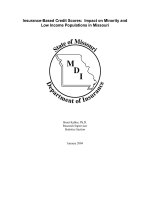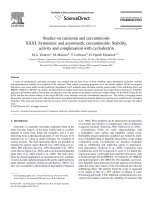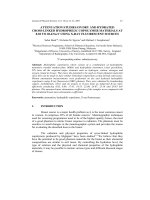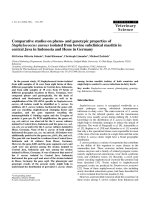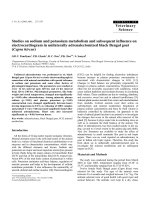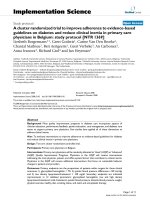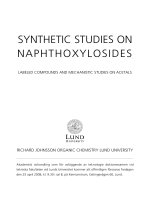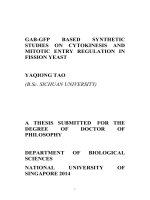GAB GFP BASED SYNTHETIC STUDIES ON CYTOKINESIS AND MITOTIC ENTRY REGULATION IN FISSION YEAST
Bạn đang xem bản rút gọn của tài liệu. Xem và tải ngay bản đầy đủ của tài liệu tại đây (27.18 MB, 207 trang )
GAB-GFP
BASED
SYNTHETIC
STUDIES ON CYTOKINESIS AND
MITOTIC ENTRY REGULATION IN
FISSION YEAST
YAQIONG TAO
(B.Sc. SICHUAN UNIVERSITY)
A THESIS SUBMITTED FOR THE
DEGREE
OF
DOCTOR
OF
PHILOSOPHY
DEPARTMENT
SCIENCES
OF
BIOLOGICAL
NATIONAL
UNIVERSITY
SINGAPORE 2014
!
i!
OF
DECLARATION
I hereby declare that the thesis is my original work and
it has been written by me in its entirety. I have duly
acknowledged all the sources of information that have
been used in the thesis.
This thesis has also not been submitted for any degree
in any university previously.
_____________
Yaqiong Tao
16th Oct 2014
!
ii!
Acknowledgement
Looking back at my entire period of graduate study, I cannot but think of
the wonderful people who have helped me through this journey. It is their
efforts that made it possible for me to reach the point of writing this
manuscript.
I thank Dr. Mohan Balasubramanian, my supervisor. His encouragement
and advices are invaluable to the work presented here. His caring for every
student under his mentorship despite changing circumstances is most
honorable. His strong devotion to science along with his charming
personality provides a lasting inspiration and motivation for me.
I am grateful to my thesis committee members, Drs. Cynthia He, Gregory
Jedd, and Ronen Zaidel-Bar for their guidance and valuable suggestions. I
also own gratitude to Drs. Jian-Qiu Wu, Sophie Martin, James Mosley,
Dan Zhang, Ulrich Rothbauer and Agnes Grallert for sharing yeast strains
and plasmids with me.
I am thankful to Dr. Yinyi Huang, Dr. Xie Tang, Dr. Meredith Calvert, Dr.
Junqi Huang, Dr. Dhivya Subramanian, Dr. Anup Padmanabhan, Dr.
Srinivas Rmanujam, Dr. Mithilesh Mishra, Mr. Mayagulu Sevugan, Miss
Krit Sethi, Miss Nan Shao, Mr. Sachin Seshadri and all past members of
the Mohan Balasubramanian group for their daily aid, discussion and
friendship. Special thanks to Dr. Junqi Huang and Dr. Yinyi Huang for
!
iii!
advice on my experiments and data processing, and Dr. Dhivya
Subramanian and Ms Kriti Sethi for their critical reading of my
manuscripts.
The work presented here was funded by the Temasek Life Sciences
Laboratory and my study was supported by the scholarship from the
National University of Singapore.
It is my family to whom I am forever grateful for their unconditional love
and support. I owe the deepest gratitude to my father Qingming Tao, my
mother Xingshu Hou and my partner Su Zhu.
!
iv!
Table of Contents
Title Page .......................................................................................................................i
DECLARATION!.............................................................................................!ii!
Acknowledgement!...........................................................................................!iii!
Table of Contents!..............................................................................................!v!
List of Tables!.....................................................................................................!x!
List of Figures !.................................................................................................!xi!
List of Abbreviations! ...................................................................................! iii!
.
x
List of Publications !......................................................................................!xiv!
Chapter I Introduction!...................................................................................!1!
1.1! Gab in cell biology studies!....................................................................!4!
1.2 S. pombe Cell Cycle and G2/M transition!............................................!7!
1.2.1 S. pombe as a model organism!....................................................................!8!
1.2.2 S. pombe cell cycle and mitotic entry!......................................................!10!
1.2.2.1 The division cell cycle!....................................................................................!10!
1.2.2.2 Mitotic entry!.......................................................................................................!11!
1.2.2.3 Cell size control and G2/M transition!.......................................................!13!
.
1.3 S. pombe Cytokinesis!..............................................................................!18!
1.3.1 Assembly of actomyosin ring in S. pombe!..............................................!19!
1.3.1.1 The molecular basis for ring assembly!......................................................!19!
1.3.1.2 Current models regarding actomyosin ring assembly!..........................!21!
1.3.1.3 Completion of cytokinesis!.............................................................................!22!
1.3.2 Division plane positioning!.........................................................................!24!
1.3.2.1 Mid1p and other overlapping factors!.........................................................!24!
1.3.2.2 Nuclear site and division plane positioning!.............................................!29!
1.4 Gaps and Objectives!...............................................................................!30!
Chapter II Materials and Methods!............................................................!33!
2.1 Yeast strains, media and reagents!.......................................................!33!
2.1.1 Yeast strains!.................................................................................................!33!
2.1.2 Growth media!..............................................................................................!37!
2.1.3 Drugs and reagents!.....................................................................................!38!
2.2 Molecular cloning and yeast genetics!..................................................!39!
2.2.1 Molecular cloning!.......................................................................................!39!
2.2.1.1 PCR!.......................................................................................................................!39!
2.2.1.2 Digestion and ligation!.....................................................................................!41!
2.2.1.3 Bacteria transformation and plasmid extraction!....................................!41!
.
2.2.1.4 Plasmids constructed!.......................................................................................!41!
2.2.2 Yeast genetics!...............................................................................................!46!
2.2.2.1 Yeast strain construction!................................................................................!46!
!
v!
2.2.2.2 Genetic crosses!..................................................................................................!49!
2.3 Yeast cell biology!.....................................................................................!49!
2.3.1 Fixation and staining!..................................................................................!49!
2.3.2 Microscopy, image processing and data analysis!.................................!51!
2.3.2.1 Epifluorescence microscopy!.........................................................................!51!
2.3.2.2 Spinning disk confocal microscopy!...........................................................!51!
2.3.2.3 Nucleus displacement experiment!..............................................................!52!
2.3.2.4 SIN inactivation experiment!.........................................................................!53!
2.3.2.5 General image processing and data analysis!...........................................!53!
2.3.2.6 Fluorescence distribution plotting!..............................................................!54!
2.3.2.7 Fluorescence Recovery after Photobleaching (FRAP)!........................!55!
Chapter III Results!........................................................................................!58!
3.1 The Gab-GFP based protein targeting method!................................!58!
3.1.1 Construction of the Gab targeting system!.............................................!58!
3.1.2 Gab-GFP complex tends to favor the location of the Gab fusion!.....!61!
3.1.3 Analysis of the Gab fusion targeting effects!..........................................!65!
3.2 Rewiring Mid1p independent medial division in S. pombe!............!68!
3.2.1 Gab-GFP based protein targeting strategy is advantageous over
direct protein fusion method!..............................................................................!69!
3.2.2 Medial targeting of Rng2p rescued mid1 mutants!...............................!75!
3.2.3 Medial actomyosin ring assembly does not require ring components
to assemble in an invariant order!......................................................................!79!
3.2.3.1 A screen for medially targeted cytokinetic proteins that rewired
medial cell division!........................................................................................................!79!
3.2.3.2 Cdc12p and Myo2p rewired nodes assembling into medial
actomyosin rings!.............................................................................................................!84!
3.2.4 Rewired nodes corrected septum positioning defects in plo1 mutant
! ..................................................................................................................................!90!
.
3.2.5 Mid1p plays multiple roles in fission yeast cytokinesis!......................!92!
.
3.2.5.1 Actomyosin ring assembly was delayed in rewired cells!...................!92!
.
3.2.5.2 SIN was required for actomyosin ring assembly in rewired cells!....!95!
3.2.5.3 Actomyosin ring components were precociously recruited in rewired
cells!......................................................................................................................................!99!
3.2.5.4 Dynamics of Myo2p was altered in rewired cells!..............................!105!
3.2.5.5 Mid1p was required for the dynamic coordination between nuclear
and division site positions!.........................................................................................!110!
3.3! Cell size sensing by Cdr2p and Pom1p!........................................!115!
3.3.1 Disrupting Cdr2p localization leads to G2 prolongation!................!118!
3.3.2 Medial targeting of Pom1p leads to G2 prolongation!......................!121!
Chapter IV Discussion!...............................................................................!125!
4.1 Gab-GFP binding based targeting strategy!....................................!125!
4.2 Synthetic rewiring studies provided new insights into S. pombe
cytokinesis!....................................................................................................!128!
.
4.2.1 Gab-GFP binding based strategy is advantageous!...........................!128!
!
vi!
4.2.2 Rng2p and actomyosin ring positioning!.............................................!130!
.
4.2.3 Order of assembly of node components is not important!...............!131!
4.2.4 Rewired cytokinesis nodes and canonical cytokinesis nodes!..........!134!
4.2.5 Nuclear and division site positions!.......................................................!137!
4.2.6 Conclusions on rewiring studies!...........................................................!139!
4.3 Cell size sensing and G2/M transition!.............................................!141!
.
Chapter V Future directions!....................................................................!144!
5.1 Building a protein targeting library based on Gab-GFP binding
!.........................................................................................................................!144!
5.2 Identification of functional epistasis groups in fission yeast
cytokinesis!....................................................................................................!145!
.
5.3. Identification of specific Mid1p interacting sites and their binding
partners using genetic code expansion strategy!...................................!147!
5.4 Examining Cdr2p as a direct cell-size sensor!.................................!149!
References!....................................................................................................!151!
.
!
vii!
Summary
Understanding the spatial and temporal regulation of proteins is one of the
key challenges in studying complex cellular processes in many cell types.
In this study, I established a protein targeting strategy based on the GabGFP binding affinity, which preferentially allowed spatial manipulation of
proteins that are fused to GFP. Synthetic protein targeting approach was
applied to investigate two essential cellular events during the fission yeast
cell cycle, i.e., cytokinesis and mitotic entry.
Like many higher eukaryotes, the fission yeast cells utilize a contractile
actomyosin ring for cell division. The Gab-GFP based protein targeting
approach synthetically rewired medial cell division in cells lacking Mid1p,
a protein thought to be key for medial actomyosin ring assembly in fission
yeast. By individually targeting the IQGAP-related Rng2p, formin-Cdc12p
and type II myosin-Myo2p to the medial cortex, the requirement for
Mid1p in organizing cytokinetic nodes for actomyosin ring assembly was
bypassed. This result also suggests that the order of assembly of ring
proteins at the division site is not essential for medial contractile ring
assembly. I further characterized ring assembly in the rewired cells in
which Rng2p, Cdc12p and Myo2p were precociously targeted to medial
nodes, and came to several important conclusions. A delay in ring
assembly was observed in the rewired cells and possible explanations were
explored. In addition, unlike wild-type cells, these cells do not actively
!
viii!
track the position of the nucleus for ring assembly and cell division. These
studies suggest that Mid1p performs multiple functions pertaining to
cytokinesis – 1) marking the medial cortex for cell division, 2) promoting
timely assembly of actomyosin ring in metaphase and 3) dynamically
aligning the position of the actomyosin ring to that of the nucleus.
In a parallel study, the Gab-GFP based protein targeting approach was
used to manipulate the spatial localization of the serine/threonine kinase
Cdr2p and the DYRK family Pom1p. Mistargeting Cdr2p to nonmedial
subcellular locations or targeting Pom1p to the medial region both led to a
prolonged G2 phase. These events were reversed by either depleting the
protein phosphatase Clp1p or mutating pom1 to a kinase-dead form pom12. These data provide direct evidence supporting that Cdr2p functions as a
read-out for cell size expansion, consistent with models proposed in
previous work (Martin and Berthelot-Grosjean, 2009; Moseley et al.,
2009). My work also reveals the complicity of multiple inputs in
regulating G2-phase / M-phase transition in fission yeast cells.
!
ix!
List of Tables
Table 1. Yeast strains used for results in chapter 3.1 & 3.3!...........................!33!
Table 2. Yeast strains used for results in chapter 3.2!.......................................!34!
Table 3. All plasmids used in this study!...............................................................!42!
Table 4. All primers used in this study!.................................................................!44!
Table 5. Paired two-sample t-test for region A among strains listed in
figure S1: tail 2, type 3!.....................................................................................!83!
.
!
x!
List of Figures
Figure 1. Construction of the Gab targeting system.!........................................!60!
Figure 2. Gab-GFP complex tends to favor the location of the Gab fusion.
!..................................................................................................................................!64!
Figure 3. Analysis of Gab targeting effects.!........................................................!67!
Figure 4. Overexpression of Cdr2p-Rng2p fusion fails to restore medial
Rng2p localization in mid1 mutants.!...........................................................!71!
Figure 5. Cdr2p-Gab-mCherry targets GFP fusions to the medial cortex.!74!
Figure 6. Medial targeting of Rng2p rescued mid1 mutants.!........................!78!
Figure 7. mid1-18 is rescued by medial targeting of Rng2p, Cdc12p and
Myo2p, but not other cytokinetic proteins.!................................................!81!
Figure 8. mid1-18 is rescued by medial targeting of Rng2p, Cdc12p or
Myo2p.!...................................................................................................................!82!
Figure 9. Rewired Cdc12p nodes compact into rings.!.....................................!87!
Figure 10. Rewired Myo2p nodes compact into rings.!....................................!88!
Figure 11. Rewired Rlc1p, Myp2p and Cdc15p nodes fail to compact into
rings.!.......................................................................................................................!89!
.
Figure 12. Septum positioning defects in plo1-1 is largely corrected by
rewiring Cdc12p.!................................................................................................!91!
Figure 13. Actomyosin rings assemble late in rewired cells.!........................!94!
Figure 14. SIN is required for actomyosin ring assembly in rewired cells.
!..................................................................................................................................!98!
Figure 15. Rlc1p is precociously recruited to medial cortex in rewired
cells.!.....................................................................................................................!102!
Figure 16. Cdc15p is precociously recruited to medial cortex in rewired
cells.!.....................................................................................................................!103!
Figure 17. Ain1p is precociously recruited to medial cortex in rewired
cells!......................................................................................................................!104!
.
Figure 18. Myo2p turnover is reduced in the presence of Cdr2p-Gab.!...!108!
Figure 19. Blt1p-Gab-mCh fails to bring GFP-Myo2p to medial nodes.!109!
Figure 20. Mid1p is required for dynamic coordination of the nuclear and
the actomyosin ring position.!.......................................................................!112!
Figure 21. Mid1p is required for dynamic coordination of the nuclear and
the actomyosin ring position.!.......................................................................!113!
Figure 22. Graphical summary of Mid1p in S.pombe cytokinesis.!...........!114!
Figure 23. Illustration of size sensing and G2/M transition.!.......................!117!
Figure 24. Disrupting Cdr2p localization leads to G2 prolongation.!.......!120!
Figure 25. Targeting Pom1p to the cell middle leads to G2 prolongation.
!...............................................................................................................................!124!
!
xi!
!
xii!
List of Abbreviations
AB
CDK
DAPI
DYRK
ER
F-actin
F-BAR
Gab
GAP
GEF
GFP
HIV
IQGAP
LB
MAPK
MBC
mCh
MM
NETO
NIMA
ORF
PCR
PM
S. pombe
SIN
SPB
SPET
STEDV
TOR
UCS
VAP
VLAP
YES
YPD
!
aniline blue
Cyclin-dependent kinase
4', 6'-diamidino-2-phenylindole
dual-specificity tyrosine-phosphorylation-regulated kinase
endoplasmic reticulum
filamentous actin
a subfamily of the Bin-Amphiphysin-Rvs domains protein
green fluorescence protein antibody
GTPase Activating Protein
guanine nucleotide exchange factors
green fluorescence protein
human immunodeficiency virus.
IQ calmodulin-binding motif containing GTPase activating
protein
Lysogeny broth
mitogen-activated protein kinase
Methyl-2-benzimidazole-carbamate
mCherry
edinburgh minimal medium
new-end-take-off
never in mitosis gene A
open reading frame
polymerase chain reaction
plasma membrane
Schizosaccharomyces pombe
the septation initiation network
spindle pole body
single-photon emission computed tomography
standard deviation
target of Rapamycin
UNC-45/CR01/She4p
vesicle-associated protein
Vaseline, Lanolin and Parafin wax
yeast extract with supplements
yeast extract peptone dextrose
xiii!
List of Publications
1. Huang J, Huang Y, Yu H, Subramanian D, Padmanabhan A, Thadani
R, Tao Y, Tang X, Wedlich-Soldner R, Balasubramanian MK.
Nonmedially assembled F-actin cables incorporate into the actomyosin
ring in fission yeast. J Cell Biol. 2012 Nov 26;199(5):831-47. doi:
10.1083/jcb.201209044.
2. Balasubramanian MK, Tao EY. Timing it right: precise ON/OFF
switches for Rho1 and Cdc42 GTPases in cytokinesis. J Cell
Biol. 2013 Jul 22;202(2):187-9. doi: 10.1083/jcb.201306152.
3. Tao EY, Calvert M, Balasubramanian MK. Rewiring Mid1pIndependent Cell Division in Fission Yeast. Accepted by Current
Biology, 2014 July.
!
xiv!
Chapter I Introduction
In both prokaryotic and eukaryotic cells, a defined cellular event often
happens at a specific subcellular location within or outside the cell. After
proper modification and folding, a protein is transported to such
subcellular location so as to interact with its binding partner(s) and fulfil
its role in a cellular event. Understanding how protein subcellular
localization is temporally and spatially regulated is a fundamental question
in cell biology. Interrupting protein localization or synthetically guiding
protein localization is a powerful strategy to understand protein function.
Currently, two major strategies are employed for protein targeting by cell
biologist. For some proteins, signal peptides are encoded in their
sequences, which directly serve as cues for their subcellular localization.
For instance, many proteins residing in the nucleus have the Nuclear
Localization Sequence (NLS), typically consisting of one or more short
sequences of positively charged lysines or arginines. The first NLS to be
identified was the sequence PKKKRKV in the SV40 Large T-antigen
(Kalderon et al., 1984). By contrast, a Nuclear Export Sequence (NES) is a
short amino acid sequence of 4 hydrophobic residues in a protein that has
the opposite effect of a NLS, i.e., guiding the export of a protein from the
cell nucleus to the cytoplasm (la Cour et al., 2004). Another large group of
signal peptides are present at the N-terminus of newly synthesized proteins
!
1!
that are destined towards the secretory pathway (Blobel and Dobberstein,
1975). Some of these proteins are transported to certain organelles such as
the endoplasmic membranes, or secreted from the cell. Such signal
peptides are widely applied in studies where protein targeting is required.
In a recent study, researchers found that manipulations (insertions and
deletions) of NLS and NES for a protein called Wee1p altered its
accumulation levels on the spindle pole body, which in turn affected its
function
in
regulating
mitotic
entry
in
the
fission
yeast
Schizosaccharomyces pombe (S. pombe) (Masuda et al., 2011).
Unfortunately, signal peptides are only available for protein targeting to a
limited number of subcellular locations such as the nucleus, the
endoplasmic reticulum and the plasma membrane. In fact, many other
proteins are delivered to their subcellular locations via protein-protein
interactions. Therefore, direct fusion of two proteins is often utilized for
protein targeting when a signal peptide is not available for a specific
location. During the establishment of polarized growth in pombe cells, the
tip complex plays an essential role and is built up in a protein-protein
interacting manner (Busch and Brunner, 2004; Busch et al., 2004). At first
Tea1p and Tea2p are transported to the cell tips through microtubules
(Sawin and Nurse, 1998). Tea1p / Tea2p stabilizes each other, and Tea1p
subsequently recruits Tea3p and Tea4p, the latter of which directly binds
to formin For3p (Arellano et al., 2002; Browning et al., 2000; Martin et al.,
!
2!
2005). These proteins together form clusters at the fission yeast cell ends
and are called the tip complex. Although both Tea1p and Tea3p
accumulate at cell tips, Dodgson et. al. found that they belong to spatially
distinct node populations.This is evident by their analysis of the fusion of
Tea1p and Tea3p, which resulted in lateral cortical mislocalization of both
polarity factors, as well as in gross polarity defects (Dodgson et al., 2013).
Thus, direct fusion of two proteins of interest, as a strategy for protein
targeting, also provides important information on how proteins function at
specific locations.
The major drawback with direct protein fusion lies in the fact that fusion
of two full-length proteins could lead to non-functionality of either or both
proteins. Furthermore, fusing two full-length proteins together is often
time consuming and is always case specific for different combinations. It
would be extremely useful to develop a simple yet universal tool for
protein targeting. The recent development of single domain antibodies, or
VHHs, and their applications in cell biology reasearch make it feasible to
develop such a tool.
The Green Fluorescence Protein Antibody (Gab) is a single domain
antibody that was first derived from Camelidae sp. by Leonhardt group,
containing the epitope recognizing fragment of the heavy-chain GFP
antibody (Rothbauer et al., 2006). Like many other VHHs, the 119 amino-
!
3!
acid Gab fragment was shown to bind with its antigen (GFP) with high
affinity in both mammalian and plant cells (Rothbauer et al., 2006;
Schornack et al., 2009). Thus, the Gab-GFP binding affinity can be
utilized to mimic a signal peptide, where a Gab fused protein A could
direct a GFP fused protein B to the subcellular location of protein A, or
vice versa.
In this study, Gab is engineered for protein targeting in fission yeast and
applied in the study of two essential cellular events that require delicate
spatial and temporal regulation of multiple proteins, i.e., cytokinesis and
mitotic entry. The following sections will present current knowledge about
1) VHHs as tools for multiple purposes in biological sciences, 2) cell cycle
regulation and cell size sensing in S. pombe, 3) mechanisms involved in S.
pombe cytokinesis, with a focus on division site positioning.
1.1 Gab in cell biology studies
!
One of the key challenges of biology in the new century is to develop an
extensive toolbox for selective probing, isolation and characterization of
proteins at specific subcellular locations. The evolutionary discovery and
application of fluorescent proteins have advanced cell biology and
biochemistry by providing easy tags to visualize proteins localizations and
dynamics in vivo (Tsien, 2009). In parallel, a wide range of selective and
!
4!
tight binding partners to various protein targets have been developed and
collectively emerged as protein scaffold libraries (Skerra, 2007). One such
development is the serendipitous discovery of single domain antibodies
that display simpler selection and improved stability (Muyldermans et al.,
2009).
Since the first discovery of bona fide heavy-chain antibodies from
Camelus dromedarius made two decades ago (Hamers-Casterman et al.,
1993), various single-domain antigen-binding fragments, also known as
VHHs or nanobodies, have received tremendous interest. With their stable
recombinant entities, these fragments are broadly applied in multiple fields
including fundamental bioresearch, diagnostics and therapeutics (De
Meyer et al., 2014). Gab, the single-domain antibody against the Green
Fluorescent Protein is one such example and has a great potential in broad
biological studies, as GFP is already extensively tagged endogenously to
various proteins in many model organisms. Here, I briefly review the
novel implementations of Gab as a tool for basic research.
Gab, or GBP (GFP Binding Protein), is fused to red fluorescent proteins
such as RFP and is termed nanobody or chromobody. Gab is highly stable,
and folds into functional antigen-binding conformation even in the
cytoplasm of different types of living cells. In the first instance, Gab-RFP
was expressed in HeLa cells and was able to trace in vivo GFP fused
!
5!
proteins that localized to cytoplasmic or nuclear locations (Rothbauer et
al., 2006; Schornack et al., 2009). Subsequent studies have utilized
nanobody for various purposes, such as isolation and redirection of GFP
fusions to alternative cellular locations (Rothbauer et al., 2008), and
alteration of plant phenotypes by trapping GFP fused proteins (Schornack
et al., 2009). Other nanobodies were made to directly visualize native
proteins (Zolghadr et al., 2012) as well as human immunodeficiency virus
(HIV) (Helma et al., 2012) in living cells.
Gab has also been applied in super-resolution microscopy to visualize GFP
fused proteins in recent studies. Conventionally, full-length antibodies are
coupled to organic dyes as primary antibodies, which may induce linkage
errors due to a distance between the localization of the protein and the
organic dye. Owing to the smaller size of Gab, coupling the dye to Gab
results in improved labeling with minimal linkage error (Ries et al., 2012).
Likewise, Gab coupled with gold nanoparticle is used to track GFP fused
membrane proteins and even allows internalization by electroporation to
track intracellular molecules in vivo (Leduc et al., 2013).
Another group developed a Gab-based fluorescent-three-hybrid approach
to study protein-protein interactions in vivo (Herce et al., 2013). In the first
step, Gab is fixed at a specific subcellular compartment by fusing to an
anchoring protein, while two proteins of interest are each fused to either
!
6!
RFP or GFP. Upon interaction, both proteins form a cluster with a strong
RFP-GFP colocalization signal at the location of the Gab fused anchoring
protein. This approach was successfully applied in human cells for
identification and analysis of peptides that inhibit protein-protein
interactions.
The molecular details including the high affinity and high specificity of
Gab-GFP complex have been revealed by Kubala et al. using X-ray
crystallography and isothermal titration calorimetry (Kubala et al., 2010).
Through these analyses, they determined the possible routes to redirect the
specificity for GFP to a variant of a closely related fluorescent protein,
CFP, thereby expanding the toolbox of fluorescent probes that can be
genetically encoded and are detectable by Gab.
Taken together, Gab has been widely implemented as a tool for labeling,
protein functional disruption and high-resolution imaging in cell biology
research. I aim to utilize Gab for protein targeting in vivo in S. pombe
cells.
1.2 S. pombe Cell Cycle and G2/M transition
!
!
7!
1.2.1 S. pombe as a model organism
The fission yeast Schizosaccharomyces pombe is a rod-shaped (12-15 µm
in length and 3-4 µm in diameter) unicecllular eukaryote that undergoes
polarized growth and divides by fission in the middle. It has emerged in
recent decades as an attractive model organism for the study of many
fundamental biological questions due to several important factors,
including its short and well characterized cell cycle, fairly large cell size
convenient for imaging and other cytological analyses, fully sequenced
and annotated genome (Wood et al., 2002) and the ease of molecular and
genetic manipulations. Though a seemingly simple cylindrical shape, a S.
pombe cell undergoes three major morphological transitions in its short
haploid vegetative cell cycle. A newly born cell (6-8 µm in length)
initiates immediate growth in a monopolar fashion at its "old end" that
existed in the previous cell cycle. When the cell achieves a sufficient size
(9.0-9.5 µm in length), it undergoes a process termed New-End-Take-Off
(NETO) and transitions to a bipolar growth fashion (Mitchison and Nurse,
1985). Finally, when the cell reaches a constant length of 13-14 µm in G2
phase, elongation at the cell tips ceases and the cell enters mitosis followed
by cytokinesis which eventually separates the cell into two daughter cells
(Mitchison and Nurse, 1985).
Similar to animal cells, S. pombe utilizes filamentious actin (F-actin) and
microtubules for growth and proliferation (Hagan and Hyams, 1988;
!
8!
Marks et al., 1986). F-actin is required to estabilsh cell polarity, to target
membrane tracfficking at the cell tips, and is essential for the assembly of
the division machinery. Microtubules are also involved in establishing cell
polarity and are key to chromosome segregation during mitosis. Although
S. pombe undergoes “closed” mitosis whereby the nuclear envelope
remains intact throughout division, the mechanisms of chromosome
condensation and segregation are similar to that of higher eukaryotic cells.
The processes of morphogenesis, growth and proliferation are tightly
linked to the specification of polarity sites in fission yeast as well as a
variety of organisms (Dettmer and Friml, 2011; Macara and Mili, 2008;
Royer and Lu, 2011; Sabherwal and Papalopulu, 2012). The specification
of cell tips in S. pombe is regulated by multipile molecular pathways and
complexes. Briefly, components of the TIP complex (Tip1p, Mal3p and
Tea2p) are delivered to cell tips through microtubules (Busch and Brunner,
2004; Busch et al., 2004), and are responsible for the recruitment of
Tea1p, a key polarity factor (Brunner and Nurse, 2000). Tea1p and other
Tea proteins are parts of a large complex termed polarisome, which also
recruits the interphase actin nucleator, formin For3p (Brunner and Nurse,
2000; Feierbach et al., 2004) and the dual-specificity tyrosinephosphorylation-regulated kinase (DYRK) Pom1p at the cell tips (Bahler
and Nurse, 2001; Bahler and Pringle, 1998). Cells deficient in TIP
complex, polarisome or pom1 form aberrant shapes such as T-shape or
!
9!
bent shape (Martin and Chang, 2005; Mata and Nurse, 1997; Verde et al.,
1995), and fail to initiate NETO (Bahler and Pringle, 1998; Tatebe et al.,
2005). The polarisome is also responsible for the regulation of Cdc42p, a
highly conserved Rho-family GTPase. Cdc42p has well characterized roles
in a number of cellular processes including cell morphogenesis, cell
adhesion, secretion, migration and cytokinesis (Etienne-Manneville, 2004;
Iden and Collard, 2008).
The polarized and periodic cell growth in S. pombe is linked with the
progression of cell cycle. Lessons learnt from yeast cell cycle have shed
light on a universal mechanism of Cyclin-dependent-kinase (CDK) based
cell cycle regulation in all eukaryotes. The following section will review
the regulation of S. pombe cell cycle with a focus on mitotic transition.
1.2.2 S. pombe cell cycle and mitotic entry
1.2.2.1 The division cell cycle
As the basic structural and functional unit of all living orgnaisms, the cell
carries all information within its compartment that is central to life. A cell
reprodues through a series of sequential events, collectively termed the cell
cycle which eventually results in two daughter cells. Some of the most
important events during the eukaryotic cell cycle are chromosome
replication occuring in S-phase and segregation of the two copies of
!
10!
chromosomes during M-phase or mitosis (Nurse, 2002). The phase
preceding S-phase (G1-phase), the phase after S-phase (G2-phase), and Sphase itself are together named interphase. M-phase or mitosis is further
divided into prophase (or pre-metaphase), metaphse, anaphase (A and B)
and telophase (or post-anaphase).
Interphase is the period of cell growth and DNA duplication. During S.
pombe S-phase, DNA is duplicated and so is the spindle pole body (SPB,
equivalent to the centrosome in higher eukaryotes). Once DNA synthesis
is completed and the cell grows to a sufficient size in G2-phase, the cell
enters mitosis, during which the duplicated chromosmes are condensed
and aligned at the cell equator by a bipolar mitotic spindle consisting of
microtubules and associated proteins. During anaphase, the mitotic spindle
elongates and orients the chromosomes towards opposite poles of the cell.
The physical separation of the cell compartment is executed by a process
termed cytokinesis, which will be reviewed in detail in chapter 1.3.
1.2.2.2 Mitotic entry
A series of classical genetic screen and mutant analyses in the fission yeast
by Paul Nurse and colleagues in the 1970s have identified “wee” (small in
Scottish) mutants that divide at abnormally small size. Subsequent work
done by Paul et al have led to the discoveries of Cdc2p that functions as an
!
11!

